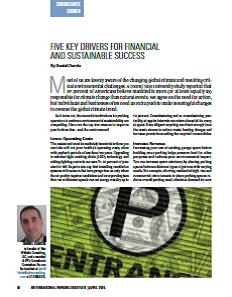Most of us are keenly aware of the changing global climate and resulting critical environmental challenges. A recent Yale University study reported that 87 percent of Americans believe mankind is more (or at least equally as) responsible for climate change than natural events. We agree on the need for action, but individuals and businesses often need an extra push to make meaningful changes to reverse the global climate trend.
As it turns out, the financial motivations for parking operators to embrace environmental sustainability are compelling. Here are the top five reasons to improve your bottom line—and the environment!
Lower Operating Costs
The easiest and most immediately beneficial actions you can take will cut your facility’s operating costs, often with payback periods of less than two years. Upgrading to efficient light-emitting diode (LED) technology and adding lighting controls can save 70-90 percent of your electric bill. Experts also say that installing ventilation systems with sensors that turn garage fans on only when the air quality requires ventilation and incorporating fans that run at different speeds can cut energy costs by up to 90 percent. Commissioning and re-commissioning your facility at regular intervals can return almost $6 for every $1 spent. Even diligent recycling can divert enough from the waste stream to reduce waste-hauling charges and increase profits from selling the recycled commodities.
Increase Revenue
Increasing your use of existing garage space before building more parking helps preserve land for other purposes and reduces your environmental impact. You can increase space efficiency by sharing parking spaces between different types of patrons with varying needs. For example, allowing residential high-rise and commercial office tenants to share parking spaces reduces overall parking need, alleviates demand for new parking facility construction, and lowers total operating costs, maximizing revenues and operational efficiency per square foot.
Attract New Business
Environmentally friendly parking facilities can attract more customers, increasing occupancy rates from conventional drivers and tapping into new markets. Electric vehicle (EV) drivers will seek out parking facilities that provide car charging equipment, while facilities that encourage ridesharing (carpools, vanpools) by reserving preferred spacing or offering other promotions will also attract new customers. You’ll sell more spaces and the garage’s ancillary services and retail operations will benefit from attracting these new markets. Providing safe and convenient bicycle parking will attract bicyclists, who will likely spend money near the facility that ultimately flows back.
Customer Satisfaction and Retention
Environmentally friendly facilities provide customers with a more satisfying experience. Decks that are well-lit with high-efficiency fixtures and bulbs allow pedestrians to feel safer and more comfortable. Efficient lighting that reduces glare and enables clear driver visibility reduces accidents inside the facility. Eliminating harsh and highly emissive cleaning chemicals, surface coatings, paints, and sealants is healthier for patrons and reduces complaints of poor air quality and breathing ailments.
Reputation and Branding
Finally, consistent and credible parking facility “greening” builds a positive brand reputation. Patrons are more loyal to brands they believe represent their values. Businesses that practice environmental sustainability and social responsibility increase their social license to operate, creating a win-win for you, your customers, and the environment.
A Windfall for You and the Environment
The ecological benefits of implementing environmentally sustainable practices within any organization are numerous, but it is hard to find an area more fertile for improving the bottom line than greening your business. The U.S. Green Building Council has concluded that LEED (Leadership in Environmental and Energy Design) certified buildings enjoy a 3 to 6 percent price premium and 8 to 10 percent higher occupancy rates than non-LEED-rated buildings. If parking operators realize even a portion of this revenue increase, it represents a potential windfall for operators who go green.
Daniel Ciarcia is founder of Two Willows Consulting, LLC, and a member of IPI’s Consultants Committee. He can be reached at dan@twowillowsconsulting.com or 617.600.8775.
TPP-2015-04-Five Key Drivers for Financial and Sustainable Success

